Urbana Coffeeshop - 121024
The Depot Coffee House – Urbana, Ohio, USACoordinates: 121024
Blind Tasking: The target is a location. Describe the target.
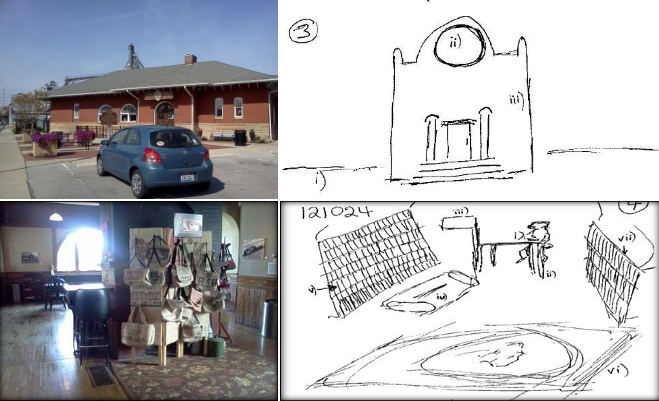
Session Summary and Sketches seen in this remote viewing educational example contributed by Intermediate Level CRV Student Avaline Jewell, United Kingdom and Basic Level CRV Student Janine Barlow, Texas, USA. CRV Analyst notes by Teresa Frisch, CRV Instructor, Analyst, Project Management
Online Discussion: October 24, 2012 (link)
Interior and exterior CRV session sketches courtesy of Avaline Jewell, UK
Feedback images courtesy of Teresa Frisch
Depot Coffee House feedback information contributed by Teresa Frisch
The Depot Coffee House, Urbana, Ohio is “steeped” in coffee, ambiance and history. The coffee shop currently occupies the building that began as a train depot (see historic marker information below). The brick, stone and concrete structure sits at an angle where the railroad tracks bisect Ohio Highway 36. Spring temperatures were a bit chilly and the sounds of birds, traffic, city noises and people talking could be heard outside. Bikers were enjoying the Simon Kenton Trail which borders the building. Prominent features surrounding the building are a granary, railroad tracks, a manufacturing plant, a bridge / overpass and a tower.
Rustic décor with arched windows let in plenty of light for the people chatting in comfortable nooks with upholstered furniture. The spacious floor plan with various tall and short tables gives plenty of opportunity for eating, drinking or the use of laptop computers. The baristas are always busy filling orders and the smell of aromatic coffees and specialty foods fills the air. Shoppers also find shelves lined with jars of colorful and taste-tempting treats and crafts both local and from around the world. The ambiance is happy, casual and comfortable, and the people appear to be enjoying themselves.
CRV Session Summary & Topology Information Contributed by Avaline Jewell, UK
The target feels: Like an outside location where there are elements of land, manmade and biological. The overall target colours are white, cream, red, green and yellow. Voices and distance echoes are heard here. The overall temperature is cold outside and warm inside. The target is bright with high contrast to its surroundings.
Land: Which is level, hard, gritty and rough.
Manmade Structure: The overall structure is large, high and which mainly consists of hard, cold, smooth, white and cream coloured material which tastes stony.
The top part of the structure is domed, curved and circular from above. At the top middle of the front of the structure is a circular, vertical, hollowed area which appears bright and feels glassy smooth.
The lower part of the structure consists of stepped, gritty, horizontals which tastes stony. Above that area is a flat area which is red, rectangular and smells woody. Either side of the red area are verticals which are solid, smooth, curved with domed tops.
The interior of the structure is bright and enclosed with an arch above. Inside this area it smells musty and woody. Within the structure there are dark, hard, smooth, woody smelling vertical and horizontal structures which contain many smooth dark objects which slide and are coloured in many shades of red, brown and green. At the far end of the interior there is an supporting a flat horizontal object which is hard, solid, smooth, reddy brown and consists of verticals There is a soft, flat, rectangular object on the floor which is green, blue and yellow.
Biological / Life: Which is a female human being wearing red and by the object at the far end of the interior.
Other things I found at the site were the sounds of voices and echoes. It felt like the structure contained historical records of importance.
Analyst Note: Images provided by Teresa Frisch, who is also the Outbounder for this target and can confirm, deny or not feedback on perceptions. Viewer makes an in-session note of “red bloused dark haired lady sat down at a desk.” Outbounder confirms that just out of camera range on the left side of the interior is a woman wearing a red blouse. She is sitting at a tall table using a laptop computer.
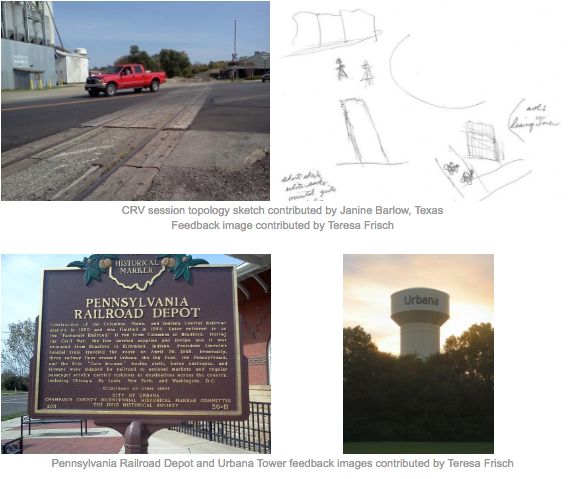
Seton Lake - 130703
Long Freight Train - Canadian Pacific Railway, Seton Lake, British ColumbiaCoordinates: 130703
Blind Tasking: The target is a location. Describe the target.

BC Hydro's Seton Dam, the final dam of the Bridge River Hydroelectric development, and the Seton Canal, which delivers water to the Seton Powerhouse and the Fraser River, are located immediately north of the campground and were built between 1927 and 1960. The Seton Powerhouse has a maximum generating capacity of 42 MW and an average capacity of 330 GWh per year -‐ roughly equal to four times the amount of electricity used by all the homes and businesses in Lillooet and Lytton, or enough to meet the energy needs of more than 300,000 homes.
The dam incorporates a fish ladder and a diversion canal, which directs water from the Seton River to the Seton Powerhouse on the Fraser River. Pink, chinook, coho and steelhead salmon are all found in the Seton River. Two Department of Fisheries and Oceans spawning channels are located near the south side of Seton River for pink salmon. Two siphons from the concrete diversion canal provide water to these channels. During the summer and fall months, the diversion of Cayoosh Creek water into Seton Lake Reservoir helps migrating salmon find their way back upstream, past the Seton Generating Station, to spawning grounds.
CRV Summary and Topology Information courtesy of Ronald Kuhn, Intermediate Level Student
The target has aspects of manmade, natural, energy, water, organic and land.
The manmade appears to have aspects of white, gray, silver, yellow, angular, wood like, damp, warm, tall, splintery, peeling paint and hard.
The natural appears to be hot, smoky, sulfur like smell, explosions, blue, orange, bright, loud sounds and open. Long, round and power lines seem present. The water seems choppy, rough, white, blue and green. Misty, cold, concrete like and across.
The organic appears present, grass like, people, yellow, brown, orange, sloped, soft, cool, smoky smell, flashes, prickly, sharp, scales, dark, night and reflective.
The land seems hard, damp smell, blankets, bottles, cans, paper, littered, grass like, fresh cut smell with a fence present.
The energy appears hot, buzzing, explosive, large, open, sparky, liquid, flowing, yellow, red, hot smell, bitter taste, ozone like, and radiation. Giving a feeling of danger.
Purpose: A place of power.
Hindu Monks - 090826
Praying For Rain, Mumbai, IndiaCoordinates: 090826
Blind Tasking: The target is a location. Describe the target.
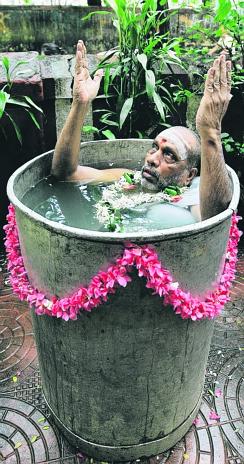
CRV Session Sketches, Summary & Topology Information
Contributed by Terri Bene, CO, USA
Feedback images and text: Courtesy of Lyn Buchanan, Problems>Solutions>Innovations
Analyst Note: Courtesy of Teresa Frisch, CRV Analyst
Hindu priests sit inside barrels containing water as they perform special prayers in order to appease Varuna, the Hindu rain god, in a temple in Mumbai. With rainfall desperately scarce recently, desperate times call for desperate measures. DNA India reported that with the rainfall not being up to the mark this season, people are trying every possible way to please the rain gods. On Wednesday, 11 priests sat neck-‐deep in water in 90cm wide drums for over three hours, chanting mantras from the Vedas at the Sri Sankara Mattham in Matunga, Mumbai. Venkataraman Shastri, 65, the head priest of 2 the temple and one of the priests who sat inside the drum, said: 'We do this to gain the goodwill of the rain god Varuna for abundant rains in the city and the country.' The belief is that the mantras help create vibrations which bring abundant rains. 'The success depends on the concentration, discipline and the pronunciation of those chanting them,' said Mr. A N Sheshan, the president of the Mattham. With this belief, the 11 priests recited mantras in one tone. Water was being poured regularly into the drums to maintain the level as the drums had leaks. (Buchanan)
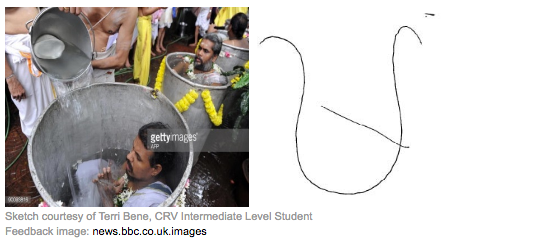
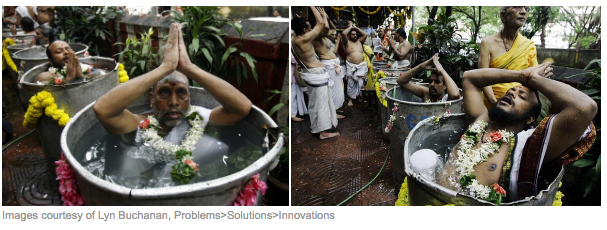
A Hindu holy man performing the Varuna Yajna ritual in Mumbai. 'The priests who took part in the ritual have undertaken training from a guru for 15 years. They practice for 15 hours every day to reach this stage,' said Mr Sheshan. Delhi faced a similar problem in June when the Indian Express reported how some residents were doing their part to bring rain. They included Mrs Sinha and her friend Madhu Singh from East Delhi who have grown up with tales of sin and repentance. They believe that if they seek the blessings of Lord Indra and please him by doing a yagna, he will send rains their way.
Pouring ghee (clarified butter) on the fire
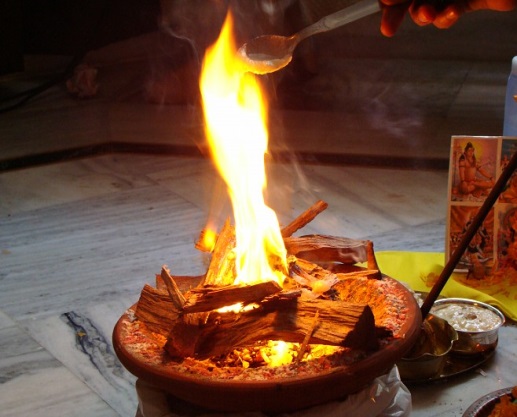
3 In 40.2 deg C heat, they sat in a circle around a fire and chanted slokas from the Rig Veda to please the rain god. As the pundit chanted mantras on the microphone, Mrs Sinha and Mrs Singh repeated them along with 50 others. After every chant, the group would pour ghee into the fire, which burnt with a fresh lease of life, making the people gathered around it sweat profusely. The heat inside was a reflection of the burning heat outside the temple. Mrs Singh said: 'Science does not have all the solutions. When you cannot irrigate your land on time, you have to turn to God for help. (Buchanan)
Sketch courtesy of Terri Bene, CRV Intermediate Level Student
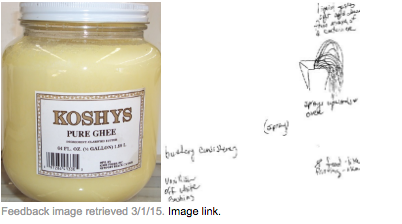
Summary and Topology Information courtesy of Terri Bene, CRV Intermediate Level Student
Analyst Note: Courtesy of Teresa Frisch, CRV Analyst
The target has aspects of biological, liquid, manmade and land.
The biological is either amphibian or reptilian-like, gray-green colored, humped with a somewhat smooth but partially roughened texture, plump-bodied, with some kind of armed appendages which are unclear (possibly webbed?), long-bodied, bulky/hefty, and low to the ground. It feels intelligent, like it knows what it is doing. It is planning something or performing something it has been trained for, and in addition it is fully aware of itself. The biological may be blind.
There is something under the biological. There is a strong perception of the biological burrowing into something, pushing or squeezing its way into something that is soft, warm and comfortable (possibly sand?). There is a curved element to the thing it is burrowing into.
The biological feels immersed in clearish liquid. It seems as though it is contained in some type of water environment. There is a feeling of fluidity and immersion and the biological seems to be enjoying it-(him – I think male)-self. There may be additional biological (people?) viewing this water creature. It feels like the biological is performing for the viewers. Liquid is dripping from it.
The manmade element is gray-green colored, fairly smooth and may have vertical and horizontal lines. It is shaped like a movie popcorn container, larger at the top than the bottom. Some part of it is arrowed and directional. Something is gushing out over the rim of this container. It may spray upward and over the side. The spray is an off-white color and may have a buttery consistency (or I may just be stuck on popcorn!).
The land element has an evening feel, soft air, warm, sandy and tranquil (except for the loud music!).
Musical sounds can be hear which seem tinny and blaring.
There is an impression of a grid-‐like or geometrical design at this site.
Overall, the activity at this target feels like a planned performance of some kind, possibly to entertain multiple viewers. The strongest impression is of some biological attempting to burrow into something.
Analyst Note: “Ghee” is clarified butter in India.
Analyst Note: Viewer describes the biological at the site as “amphibian or reptile-like.” Feedback information states that the monks train for 15 hours per day for 15 years to “get to this stage.” By tolerating both environments during the span of 24 hours the monks are equally at home in water or land environments.
dictionaryreference.com: living or able to live both on land and in water; belonging to both land and water; capable of operating on both land and water; combining two qualities, kinds, traits, etc.; of or having a mixed or twofold nature.
Retrieved 3/1/15. http://dictionary.reference.com/browse/amphibious
dictionary.com: “The Greek prefix amphi-‐means "both," or "double," and the Greek word bios means "life." Both these elements are widely used in English scientific terminology: bios, for example, is seen in such words as biology, antibiotic, and symbiotic.”
Retrieved 3/1/15. http://dictionary.reference.com/browse/amphibian
Wieliczka Salt Mine - 130501
Wieliczka Salt Mine - An Astounding Subterranean Salt CathedralCoordinates: 130501
Blind Tasking: The target is a location. Describe the target.
Online Discussion: https://www.youtube.com/watch?v=CHbAKTbIQBo
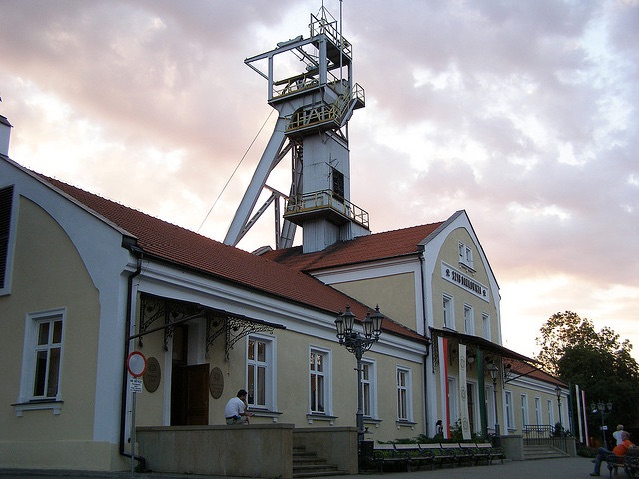
CRV Session Sketches, Summary & Topology Information contributed by M.M.B, Ohio, USA
Feedback images and text courtesy of Lyn Buchanan, Problems>Solutions>Innovations target pool
CRV Analyst Comment by Teresa Frisch
Deep underground in Poland lies something remarkable but little known outside Eastern Europe. For centuries, miners have extracted salt there, but left behind things quite startling and unique. Take a look at the most unusual salt mine in the world. From the outside, Wieliczka Salt Mine doesn’t look extraordinary. It looks extremely well kept for a place that hasn’t minded any salt for over ten years but apart from that it looks ordinary. However, over two hundred meters below ground it holds an astonishing secret. This is the salt mine that became an art gallery, cathedral and underground lake.
Situated in the Krakow area, Wieliczka is a small town of close to twenty thousand inhabitants. It was founded in the twelfth century by a local Duke to mine the rich deposits of salt that lie beneath. Until 2 1996 it did just that but the generations of miners did more than just extract. They left behind them a breathtaking record of their time underground in the shape of statues of mythic, historical and religious figures. They even created their own chapels in which to pray. Perhaps their most astonishing legacy is the huge underground cathedral they left behind for posterity.
It may feel like you are in the middle of a Jules Verne adventure as you descend in to the depths of the world. After a one hundred and fifty meter climb down wooden stairs the visitor to the salt mine will see some amazing sites. About the most astounding in terms of its sheer size and audacity is the Chapel of Saint Kinga. The Polish people have for many centuries been devout Catholics and this was more than just a long term hobby to relieve the boredom of being underground. This was an act of worship. (Buchanan)
Chapel of St. Kinga feedback image credit King of Herrings, Flicker
Sketch courtesy of M.M.B., Intermediate Level CRV Student
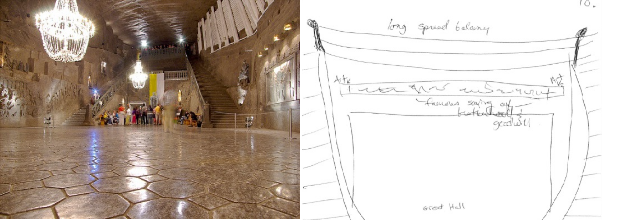
Amazingly, even the chandeliers in the cathedral are made of salt. It was not simply hewn from the ground and then thrown together; however, the process is rather more painstaking for the lighting. After extraction the rock salt was first of all dissolved. It was then reconstituted with the impurities taken out so that it achieved a glass-‐like finish. The chandeliers are what many visitors think the rest of the cavernous mine will be like as they have a picture in their minds of salt as they would sprinkle on their meals! However, the rock salt occurs naturally in different shades of grey (something like you would expect granite to look like).
Still, that doesn’t stop well over one million visitors (mainly from Poland and its eastern European neighbors) from visiting the mine to see, amongst other things, how salt was mined in the past.
For safety reasons less than one percent of the mine is open to visitors, but even that is still almost four kilometers in length – more than enough to weary the average tourist after an hour or two. The mine was closed for two reasons – the low price of salt on the world market made it too expensive to 3 extract here. Also, the mine was slowly flooding – another reason why visitors are restricted to certain areas only. (Buchanan)
The religious carvings are, in reality, what draw many to this mine – as much for their amazing verisimilitude as for their Christian aesthetics. The above shows Jesus appearing to the apostles after the crucifixion. He shows the doubter, Saint Thomas, the wounds on his wrists.
Another remarkable carving, this time a take on The Last Supper. The work and patience that must have gone in to the creation of these sculptures is extraordinary. One wonders what the miners would have thought of their work going on general display? They came to be quite used to it, in fact, even during the mine’s busiest period in the nineteenth century. The cream of Europe’s thinkers visited the site – you can still see many of their names in the old visitor’s books on display.
These reliefs are perhaps among some of the most iconographic works of Christian folk art in the world and really do deserve to be shown. It comes as little surprise to learn that the mine was placed on the original list of UNESCO World Heritage Sites back in 1978.
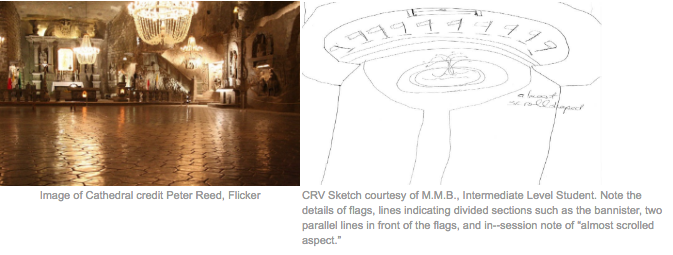
Not all of the work is relief-‐based. There are many life sized statues that must have taken a considerable amount of time – months, perhaps even years – to create. Within the confines of the mine there is also much to be learned about the miners from the machinery and tools that they used – many of which are on display and are centuries old. A catastrophic flood in 1992 dealt the last blow to commercial salt mining in the area and now the mine functions purely as a tourist attraction. Brine is, however, still extracted from the mine – and then evaporated to produce some salt, but hardly on the ancient scale. If this was not done, then the mines would soon become flooded once again.
Not all of the statues have a religious or symbolic imagery attached to them. The miners had a sense of humor, after all! Here can be seen their own take on the legend of Snow White and the Seven Dwarves. The intricately carved dwarves must have seemed to some of the miners a kind of ironic depiction of their own work.
Feedback image courtesy of Lyn Buchanan, Problems>Solutions>Innovations
Sketch courtesy of M.M.B., Intermediate Level CRV Student
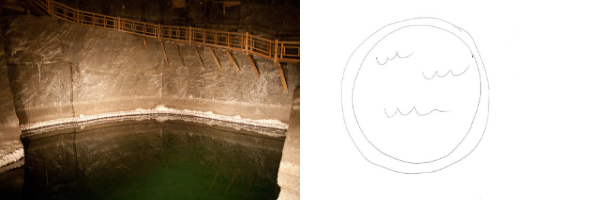
The miners even threw in a dragon for good measure! Certainly, they may have whistled while they did it but the conditions in the salt mine were far from comfortable and the hours were long – the fact that it was subterranean could hardly have added to the excitement of going to work each morning.
To cap it all there is even an underground lake, lit by subdued electricity and candles. This is perhaps where the old legends of lakes to the underworld and Catholic imagery of the saints work together to best leave a lasting impression of the mine. How different a few minutes reflection here must have been to the noise and sweat of everyday working life in the mine.
CRV Session Summary and Topology Information M.M.B., Intermediate Level CRV Student, Ohio
The target has aspects of manmade, motion, land, biologicals and water.
The manmade was a large classically designed building.
The motion was of groups of many nationalities coming and going. In and out, up and down. “Next.”
The land felt like the middle of a busy city. Well landscaped and marked by paths and flags and signs.
The biologicals were varied. Small groups representing issues. Listening attentively. Smaller groups outside main areas touring, photographing.
The water was in drinking fountains and artificial decorative areas (feng shui).
Analyst Note: Viewer felt it was “too crowded” to view this location during the day hours, so gave herself a move command to view the location when it would be less busy.